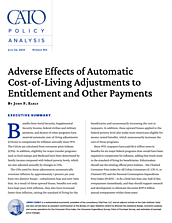1. Board of Trustees, Federal Old-Age and Survivors Insurance and Federal Disability Insurance Trust Funds, The 2022 Annual Report of the Board of Trustees of the Federal Old-Age and Survivors Insurance and Federal Disability Insurance Trust Funds (Washington: Social Security Administration, June 2, 2022), pp. 25–50, 66–74.
2. Barry F. Huston, “Social Security: What Would Happen If the Trust Funds Ran Out?,” Congressional Research Service, RL33514, September 28, 2022, p. 11.
3. Board of Trustees, Federal Old-Age and Survivors Insurance and Federal Disability Insurance Trust Funds, The 2022 Annual Report of the Board of Trustees of the Federal Old-Age and Survivors Insurance and Federal Disability Insurance Trust Funds (Washington: Social Security Administration, June 2, 2022), p. 72.
4. Office of the Chief Actuary, Social Security Administration, Summary of Provisions That Would Change the Social Security Program (Washington: Social Security Administration, February 21, 2023). The proposals labeled A3 and A8 recommend using the chained CPI‑U for COLAs. (Although the summary listing of A3 incorrectly specifies a chained CPI‑W, which does not exist, the source document to which it refers correctly identifies the chained CPI‑U.)
5. Bureau of Labor Statistics, “Frequently Asked Questions,” Newsroom, December 29, 2016.
6. Bureau of Labor Statistics, “Consumer Price Index: History,” in Handbook of Methods (Washington: Bureau of Labor Statistics Publishing, February 21, 2023).
7. The following are examples of applications that adopted the CPI‑U: adjustment of poverty thresholds, real average hourly earnings for all employees, household income (which later switched to the CPI-RS [CPI Research Series], a variation on the CPI‑U that revised historical data where possible when improvements were introduced in the current indexes).
8. This belief also drove Congress to appropriate additional funds so the CPI‑W could be calculated based on an entirely independent sample of outlets and items. After two years and virtually no difference between the two indexes, Congress dropped the extra appropriations, but the CPI‑W continued using the same samples as the CPI‑U but just weighting the items in the two indexes by different weights from the Consumer Expenditure Survey.
9. Computed from the Board of Trustees, Federal Old-Age and Survivors Insurance and Federal Disability Insurance Trust Funds, The 2022 Annual Report of the Board of Trustees of the Federal Old-Age and Survivors Insurance and Federal Disability Insurance Trust Funds (Washington: Social Security Administration, June 2, 2022), p. 100, Table V.A4.
10. Bureau of Economic Analysis, “National Income and Product Accounts Table 3.12” September 30, 2022.
11. Social Security Administration, Annual Statistical Supplement to the Social Security Bulletin, 2022 (Washington: Social Security Administration, December 2022), Tables 7.A3 and 7.A4.
12. Katelin P. Isaacs, “Federal Employees’ Retirement System: Summary of Recent Trends,” Congressional Research Service, 98–972, January 10, 2020.
13. Katelin P. Isaacs, “Federal Employees’ Retirement System: Summary of Recent Trends,” Congressional Research Service, 98–972, January 10, 2020, p. 9.
14. Office of the Actuary, Statistical Report on the Military Retirement System: Fiscal Year Ended September 30, 2021 (Alexandria, VA: U.S. Department of Defense, September 2022), pp. 6–8, 11, 12, and 15.
15. Bureau of Labor Statistics, “Frequently Asked Questions,” Newsroom, December 29, 2016.
16. The mentioned reports are Price Statistics Review Committee (George Stigler, chair), “Front Matter to the Price Statistics of the Federal Government,” in The Price Statistics of the Federal Government (Cambridge, MA: National Bureau of Economic Research, 1961); Advisory Commission to Study the Consumer Price Index (Michael Boskin, chair), Toward a More Accurate Measure of the Cost of Living: Final Report to the Senate Finance Committee (Washington: Government Printing Office, December 1996); and the National Commission on Fiscal Responsibility and Reform, The Moment of Truth (Washington: The White House, December 2010).
17. See Robert J. Gordon, “The Boskin Commission Report: A Retrospective One Decade Later,” National Bureau of Economic Research Working Paper no. 12311, June 2008; Bruce D. Meyer and James X. Sullivan, “Winning the War on Poverty: Poverty from the Great Society to the Great Recession,” National Bureau of Economic Research Working Paper no. 18718, January 2013; Brent R. Moulton, The Measurement of Output, Prices, and Productivity: What’s Changed Since the Boskin Commission? (Washington: Brookings Institution, July 2018); and Phil Gramm, Robert Ekelund, and John Early, The Myth of American Inequality: How Government Biases Policy Debate (Lanham, MD: Rowman & Littlefield, 2022), pp. 83–98.
18. Bureau of Labor Statistics, “CPI Average Price Data, U.S. City Average (AP),” unweighted annual averages of monthly data.
19. Bureau of Labor Statistics, “Consumer Expenditure Survey.”
20. In recent years, improvements have been made in the official CPI that reduce the effects of substitution among very similar items—for example, between brands, different sizes of packaging, and some differences in outlets. The historical data, however, do not have those improvements, and the effects of substitution across more distantly related items like those shown here remain. The BLS estimates that these improvements reduce the annual change in the CPI by approximately 0.2 percent per year. See Kenneth V. Dalton, John S. Greenlees, and Kenneth J. Stewart, “Incorporating a Geometric Mean Formula into the CPI,” Monthly Labor Review 121, no. 10 (October 1998): 3–7.
21. Bureau of Labor Statistics, “Frequently Asked Questions about the Chained Consumer Price Index for All Urban Consumers (C‑CPI‑U),” December 20, 2019.
22. Robert Cage, John Greenlees, and Patrick Jackman, “Introducing the Chained Consumer Price Index,” presented at the Seventh Meeting of the International Working Group on Price Indices, Paris, France, May 2003.
23. The formulas used for the C‑CPI‑U and PCEPI are both members of a class of price indexes called “superlative” price indexes that avoid the upward bias from substitution. The C‑CPI‑U uses a Tornqvist formula and the PCEPI uses a Fisher Ideal formula. The practical differences between the two are very small and both are widely recognized. See Bureau of Labor Statistics, “An Introductory Look at the Chained Consumer Price Index.” More comprehensive background can be found in Robert Cage, John Greenlees, and Patrick Jackman, “Introducing the Chained Consumer Price Index,” presented at the Seventh Meeting of the International Working Group on Price Indices, Paris, France, May 2003.
24. Robert J. Gordon, “The Boskin Commission Report: A Retrospective One Decade Later,” National Bureau of Economic Research Working Paper no. 12311, June 2008.
25. Phil Gramm, Robert Ekelund, and John Early, The Myth of American Inequality: How Government Biases Policy Debate (Lanham, MD: Rowman & Littlefield, 2022), pp. 83–98, 142–148.
26. Elizabeth Arias and Jiaquan Xu, “United States Life Tables, 2017,” National Vital Statistics Reports 68, no. 7 (June 24, 2019): 53.
27. See Robert J. Gordon, “The Boskin Commission Report: A Retrospective One Decade Later,” National Bureau of Economic Research Working Paper no. 12311, June 2008; Bruce D. Meyer and James X. Sullivan, “Winning the War on Poverty: Poverty from the Great Society to the Great Recession,” NBER Working Paper no. 18718, January 2013; and Brent R. Moulton, The Measurement of Output, Prices, and Productivity: What’s Changed Since the Boskin Commission? (Washington: Brookings Institution, July 2018).
28. Bureau of Labor Statistics, “Measuring Price Change in the CPI: Telephone Hardware, Calculators, and Other Consumer Information Items,” Consumer Expenditure Survey, February 10, 2023. Augmented with communications to author from Robert Cage, assistant commissioner, Bureau of Labor Statistics, September 24, 2020. The BLS has not developed an estimate of the effects of this improvement, but other research has shown they are likely significant. See for example, Erik Brynjolfsson et al., “GDP‑B: Accounting for the Value of New and Free Goods in the Digital Economy,” National Bureau of Economic Research Working Paper no. 25695, March 2019.
29. Elaine M. Cardenas, “Revision of the CPI Hospital Services Component,” Monthly Labor Review 119, no. 12 (December 1996): 40–48.
30. Over time the expenditure weights in the CPI would reflect this change in resource consumption, but the CPI prices did not show the decline in resources required as a decline in price even though the fewer resources produced a superior outcome. Because peptic ulcer treatment was really the item consumed (not surgery, medicine, nurses, etc.), the drop in the overall cost of treatment should have shown up as a price decline. It did not.
31. Bureau of Labor Statistics, “Disease-Based Price Indexes,” Price and Index Number Research, March 25, 2022.
32. The original Boskin commission estimates of the overall upward bias of the CPI (including both substitution and new product) was 1.3 percent per year before 1996 and 1.1 percent per year after that. Meyer/Sullivan and Gordon’s conservative 10-year estimate is 0.8 percent per year. Gordon also urged a reexamination that suggested it might be as large as 1.0 percent. Moulton calculates 0.85 percent per year. This analysis adopts the most conservative 0.8 percent per year for recent years to avoid any overstatement of the case.
33. White House Council of Economic Advisors, Economic Report of the President together with the Annual Report of the Council of Economic Advisers (Washington: Government Printing Office, January 1964), p. 62.
34. Gordon M. Fisher, “The Development and History of the Poverty Thresholds,” Social Security Bulletin 55, no. 4 (Winter 1992): 16. The substance of this memorandum was incorporated into Office of Management and Budget Statistical Policy Directive 14, May 1978, and continues as the official basis for the calculation. This definition was administratively determined by OMB.
35. This paper documents the excessive transfer payments that occur as the result of using biased estimates of inflation. The FPL also suffers from another statistical failure. The Census Bureau fails to count 88 percent of the transfer payments that go to households classified as poor. It ignores food stamps, refundable tax credits, Medicaid, most housing subsidies, and more than 100 other sources of income to these families. If, in addition to applying unbiased price index, all the missing income were counted, then the number of people meeting the FPL standards to qualify for benefits would be reduced by more than 98 percent. See Phil Gramm, Robert Ekelund, and John Early, The Myth of American Inequality: How Government Biases Policy Debate (Lanham, MD: Rowman & Littlefield, 2022), pp. 37, 95.
36. Board of Trustees, Federal Old-Age and Survivors Insurance and Federal Disability Insurance Trust Funds, The 2022 Annual Report of the Board of Trustees of the Federal Old-Age and Survivors Insurance and Federal Disability Insurance Trust Funds (Washington: Social Security Administration, June 2, 2022), pp. 67, 163–66, 213–14.
37. See Phil Gramm, Robert Ekelund, and John Early, The Myth of American Inequality: How Government Biases Policy Debate (Lanham, MD: Rowman & Littlefield, 2022), pp. 83–98, 142–148, 171; Robert J. Gordon, “The Boskin Commission Report: A Retrospective One Decade Later,” National Bureau of Economic Research Working Paper no. 12311, June 2008; Bruce D. Meyer and James X. Sullivan, “Winning the War on Poverty: Poverty from the Great Society to the Great Recession,” National Bureau of Economic Research Working Paper no. 18718, January 2013; and Brent R. Moulton, The Measurement of Output, Prices, and Productivity: What’s Changed Since the Boskin Commission? (Washington: Brookings Institution, July 2018).
38. Author’s budget estimates based on previous experience conducting research on this topic and budgeting for similar work as assistant commissioner at the Bureau of Labor Statistics. First three years based on work of 29 in-house economists at federal pay grades between GS‑9 and GS-15 and a similar amount of work by contracted outside experts. Ongoing effort based on 19 in-house economists and the equivalent of about 10 contracted outside experts. Estimates include salary, benefits, and overhead support.



